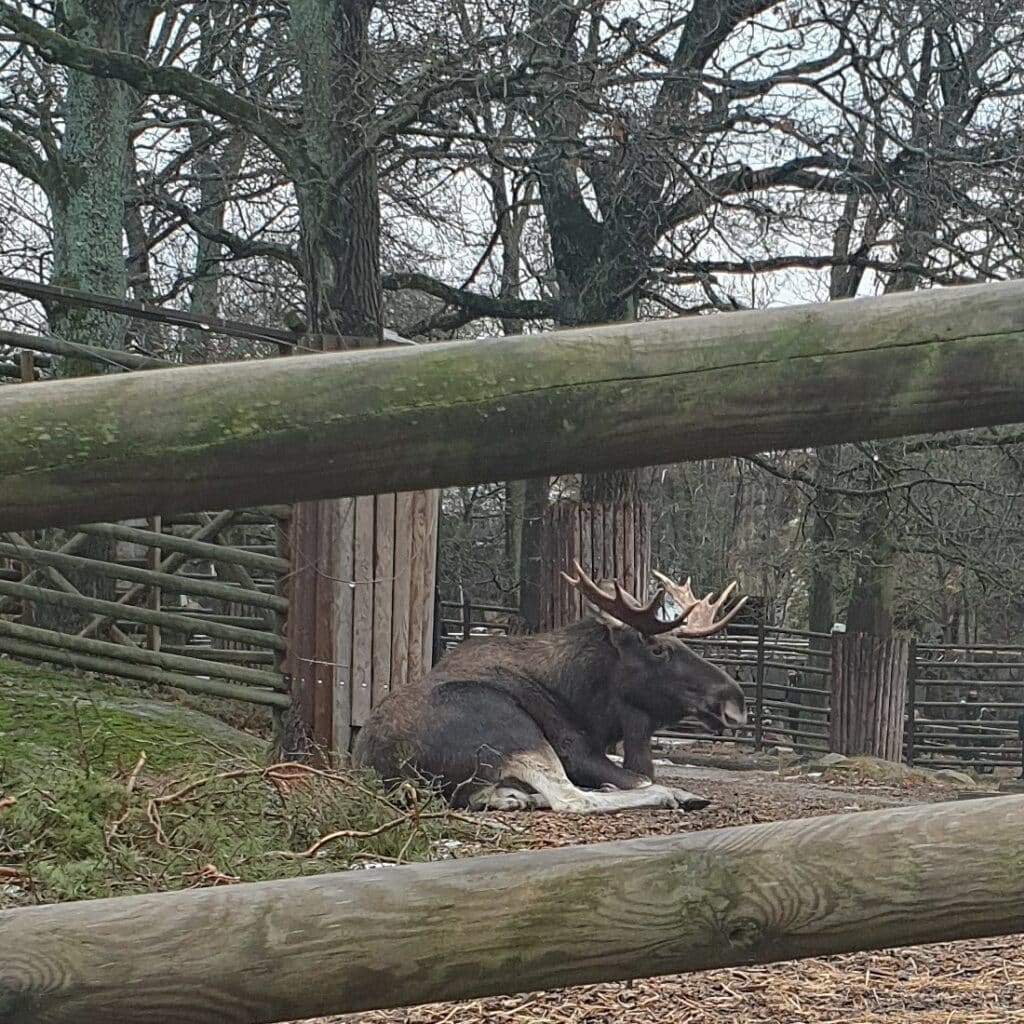Have you ever found yourself on a Swedish road trip, gazing out at a majestic creature and wondering, “Is that a moose or a reindeer?” These two iconic animals are often spotted in the Scandinavian nature, their impressive size and unique features captivating visitors. While they might seem similar at first glance, moose and reindeer possess distinct characteristics that set them apart. Let’s dive into this part of Swedish wildlife and learn how to tell them apart.
Elk (moose) and reindeer both belong to the false deer or Capreolinae which is a subfamily of the deer. In the Swedish nature you can encounter both elk and reindeer but how do you know which one it is? What is the difference between an elk and a moose? And where in Sweden can you see elk and/or reindeer?
Elk vs moose
The name can cause confusion because in British English it’s an elk, while in North America they say moose. An elk also exists in North America but then we are talking about a different kind of deer. I’ll use ‘moose’ in this article as most Swedes will use this too.
The moose, the king of the forest

Imagine stumbling upon the king of the Swedish forest: the majestic moose. With its towering stature, massive antlers, and distinctive hump, it’s a sight to behold. As you watch it graze on the tender shoots of pine trees, you can’t help but feel a sense of awe at this magnificent creature.
The moose or alces alces (‘älg’ in Swedish) is the largest mammal in the deer family. Moose are good swimmers and divers: they can dive 5 meters deep into a lake in search of food. The moose primarily feeds on pine shoots, twigs, and willow or poplar bark. In winter, a moose eats about 10 kg per day! The calves are born in late spring.
Sweden is known for its large-scale moose hunts, it is said to hunt around 80,000 moose each year. The total population in Sweden is around 300,000 moose. Thousands of moose also die in traffic accidents each year. So be careful when driving in Sweden: a moose will cross the road without checking if a car is coming.
Did you know that you can also see white moose (with blue eyes) in Scandinavia? This is due to a gene mutation. The white moose are mainly found in Värmland, although they are seen in more and more regions.
Where can you see moose in Sweden?
Moose live mainly in coniferous forests. They prefer a swampy area near a lake. Moose are quite shy animals. You have to be lucky to see one in the wild. Keep your eyes open! They are great at playing hide and seek in the forest.
Tip: if you want to see moose in the wild, go out early in the morning or towards dusk, then you have a better chance of seeing a moose.
No luck in the wild? A zoo or moose park will give you another chance of seeing them. For example, I saw moose in Skansen and in Öster Malma wildlife park. In this wildlife park they have very spacious enclosures. The chance that you will spot moose here is big, but not guaranteed. You can also book a moose safari with a guide. Highly recommended if you want to learn more about these animals.
Bonus tip: buy your Skansen entrance ticket here at the best price and avoid the queue at the ticket office. Or choose a wildlife safari with dinner by a campfire near Stockholm.
The reindeer, Santa’s friend
The reindeer or Rangifer tarandus (‘ren’ in Swedish) causes less confusion because everyone generally knows the animal as Rudolph, Santa’s friend. In North America, they sometimes use the word caribou when talking about a reindeer.
The reindeer is the only deer species that has been domesticated. Reindeer are of great importance to the Sami, the original inhabitants of Lapland, who use them for transport, but also for their milk, meat and skin. The animals are excellent swimmers and are herd animals.
There are about 250,000 reindeer in Sweden. The baby reindeer or calves are born in mid-spring. Reindeer mainly eat lichen.
Where can you see reindeer in Sweden?
During my trip with Inlandsbanan we saw several reindeer. The train had to stop regularly because they were standing on the tracks. Because of the connection with the Sami, all regions north of Dalarna offer a possibility to see reindeer in the wild.
Do you know the big 4 of Scandinavia?
What is the main difference between a reindeer and a moose?
The two species have many similarities but also many differences. Here are the most striking differences that will help you identify them:
Herd vs no herd
Do you see a large herd? Then you can say with great certainty that you spotted reindeer! Moose generally live solitary. During the winter they sometimes gather in small mixed herds.
Antlers
In deer, it is often only the males that have antlers, the reindeer is an exception! Here, both sexes carry large and widely spaced antlers. So if you see an animal without antlers, you can be almost certain that it is a female moose. Note: male moose shed their antlers in the autumn, after the rutting season. In reindeer, the male also loses his antlers after the rutting season.
Did you know that a moose’s antlers can easily weigh 20 kg?
Size moose vs reindeer
Perhaps the easiest difference to spot is size. Reindeer are on average much smaller than moose, they grow to a maximum height of 125 cm and about 225 cm long, while moose grow to a shoulder height of 2 meters and 40 centimeters high and have a length of 3 meters. Female moose are a bit smaller but still 180 cm high and 250 cm long. There is also a difference in weight, the moose grows to a maximum of 800 kg and the reindeer weighs only 300 kg.
In summary
| Characteristic | Moose | Reindeer |
| Size | Large | Small |
| Antlers | Large, leaf-shaped antlers only in males | Branched antlers in both males and females |
| Habitat | Wooded areas with water | Forests and tundras |
| Behaviour | Solitary | Living in large herds |
By understanding the key differences between moose and reindeer, you’ll be better equipped to appreciate these magnificent creatures on your next Swedish adventure. Whether you’re exploring the vast forests or the tundra, keep your eyes peeled for these iconic animals and their unique adaptations to their environment.
Pin for later
Save this article to Pinterest for later reference!





